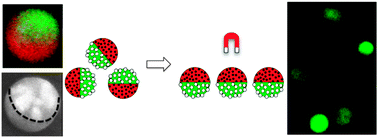Anisotropic hybrid particles based on electrohydrodynamic co-jetting of nanoparticle suspensions†
Abstract
Electrohydrodynamic co-jetting of two different

- This article is part of the themed collection: Supraparticle physical chemistry
* Corresponding authors
a
Department of Chemical Engineering, University of Michigan, Ann Arbor, USA
E-mail:
lahann@umich.edu
b Department of Macromolecular Science and Engineering, University of Michigan, Ann Arbor, USA
c Department of Physics, University of Michigan, Ann Arbor, USA
d Department of Biomedical Engineering, University of Michigan, Ann Arbor, USA
e Department of Materials Science and Engineering, University of Michigan, Ann Arbor, USA
Electrohydrodynamic co-jetting of two different

 Please wait while we load your content...
Something went wrong. Try again?
Please wait while we load your content...
Something went wrong. Try again?
S. Hwang, K. Roh, D. W. Lim, G. Wang, C. Uher and J. Lahann, Phys. Chem. Chem. Phys., 2010, 12, 11894 DOI: 10.1039/C0CP00264J
To request permission to reproduce material from this article, please go to the Copyright Clearance Center request page.
If you are an author contributing to an RSC publication, you do not need to request permission provided correct acknowledgement is given.
If you are the author of this article, you do not need to request permission to reproduce figures and diagrams provided correct acknowledgement is given. If you want to reproduce the whole article in a third-party publication (excluding your thesis/dissertation for which permission is not required) please go to the Copyright Clearance Center request page.
Read more about how to correctly acknowledge RSC content.
 Fetching data from CrossRef.
Fetching data from CrossRef.
This may take some time to load.
Loading related content
